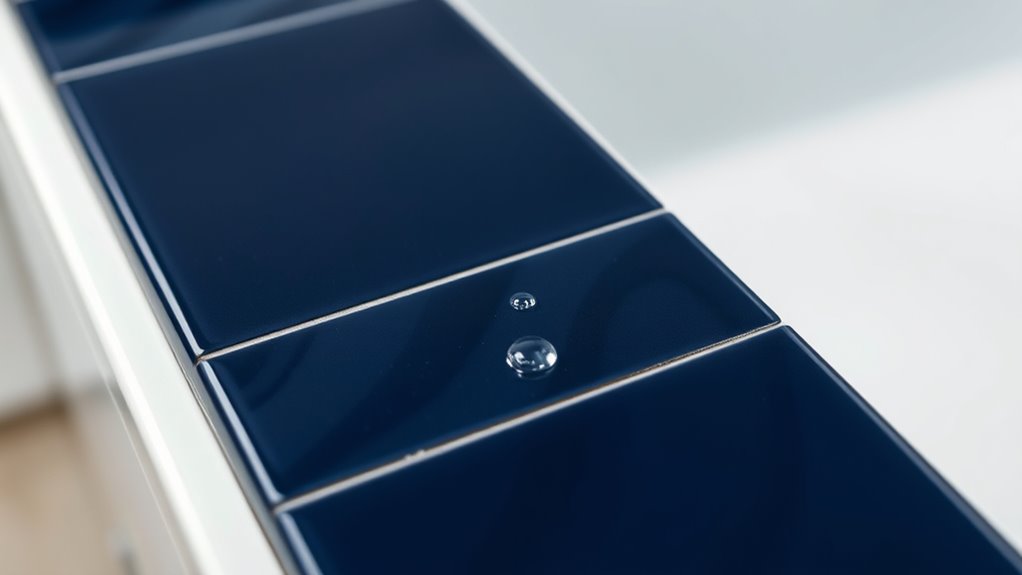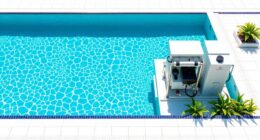For long-lasting waterline tiles, choose durable ceramic or porcelain materials that resist moisture and water damage. Opt for classic patterns like herringbone or subway for timeless appeal, and select epoxy grout for maximum stain and crack resistance. Proper surface prep guarantees adhesion and prevents issues later. If you keep exploring, you’ll discover how to select the best patterns and maintenance tips to keep your tiles looking perfect for years.
Key Takeaways
- Use durable, water-resistant materials like porcelain or glazed ceramic tiles for longevity and minimal maintenance.
- Opt for classic patterns such as subway or herringbone for timeless appeal and easier installation.
- Choose epoxy grout for superior stain resistance and moisture protection in waterline applications.
- Properly prepare surfaces by cleaning, leveling, and removing mold to ensure strong adhesion and prevent future issues.
- Regularly seal grout and maintain cleanliness to extend the lifespan and preserve the appearance of waterline tiles.
Best Materials for Waterline Tiles
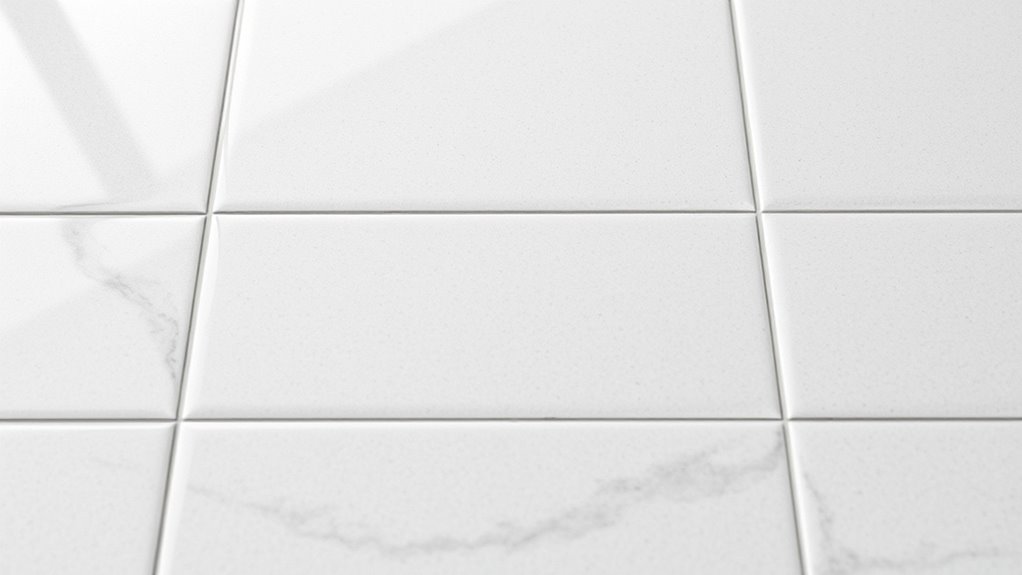
Choosing the right materials for waterline tiles is essential because this area is constantly exposed to water and moisture. You want materials that resist water absorption, preventing mold, mildew, and damage over time. Ceramic and porcelain tiles are popular choices because they’re durable and water-resistant. Porcelain, in particular, has a dense composition that makes it highly resistant to moisture. Natural stone tiles like marble or slate can look stunning but require sealing and maintenance to withstand water exposure. Glass tiles are another excellent option, offering a sleek, modern look while being waterproof. Avoid materials that are porous or easily damaged by water, as they can degrade quickly and lead to costly repairs. Selecting the right material guarantees your waterline stays beautiful and intact for years.
Popular Pattern Ideas for Waterline Installations
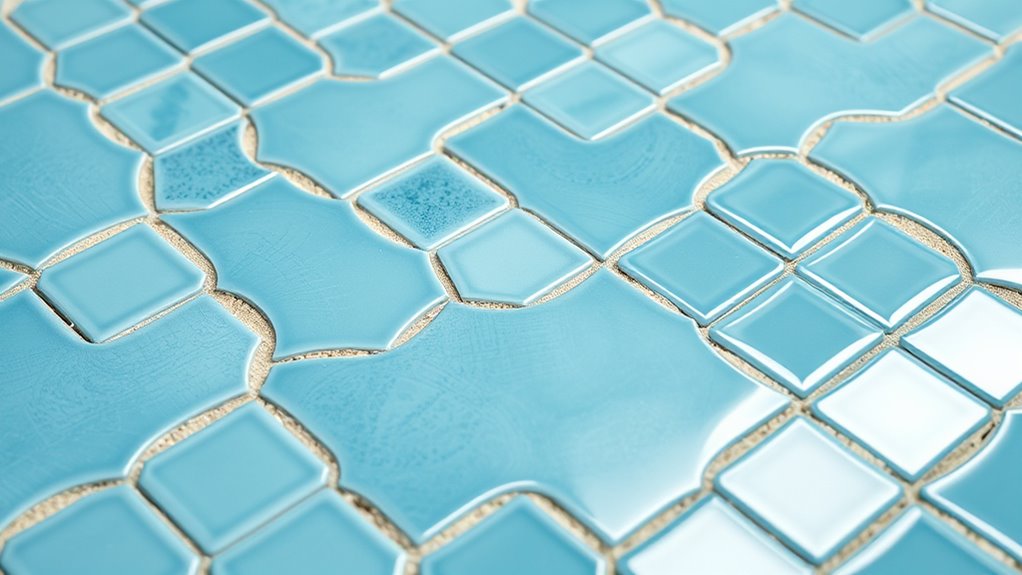
Adding a patterned design to your waterline tile can transform a simple space into a striking focal point. Popular patterns include classic herringbone, which adds visual interest with its zigzag layout, and subway tiles arranged in a running bond for a timeless look. Diagonal layouts create a sense of movement, making your space feel more dynamic. Moroccan-inspired mosaics introduce intricate details and rich textures, perfect for a bold statement. If you prefer a modern vibe, try grid patterns with large tiles for clean, straight lines. Combining different shapes, like hexagons or octagons, can add geometric flair. Consider mixing patterns for a unique, personalized effect. Incorporating interior design principles can help you choose the best pattern for your space and style. These pattern ideas let you express your style while enhancing the overall aesthetic of your waterline.
Choosing the Right Grout for Longevity and Style
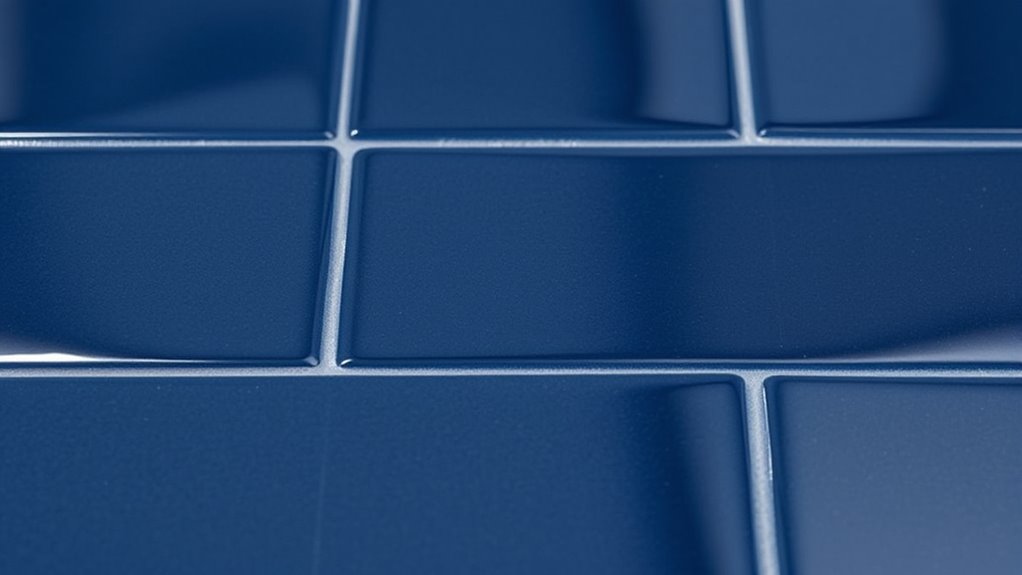
Have you considered how the grout you select can impact both the durability and appearance of your waterline tile? Choosing the right grout involves balancing practicality with style. For lasting performance, opt for epoxy grout, which resists stains, moisture, and cracking better than traditional cement-based options. If you prefer a seamless look, choose a grout color that matches your tiles to create a unified appearance. Conversely, contrasting grout can highlight patterns and add visual interest. Keep in mind that lighter shades tend to show less dirt and stains over time, reducing maintenance. Also, consider the porosity of the grout; less porous options last longer in humid environments. Additionally, proper maintenance and regular cleaning can significantly extend the life of your grout and tiles. By selecting the right grout, you enhance your tile’s longevity and guarantee it maintains its aesthetic appeal for years to come.
Maintenance Tips to Keep Waterline Tiles Looking New
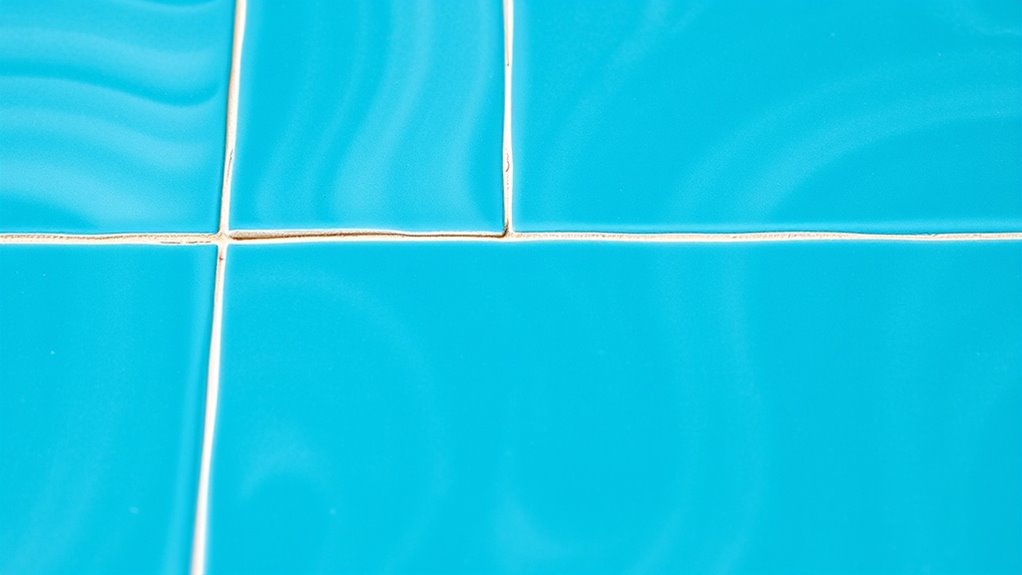
To keep your waterline tiles looking their best, establish a regular cleaning routine to remove dirt and grime. Address grout repairs promptly to prevent water damage, and reapply sealant as scheduled to safeguard against stains and moisture. Staying consistent with these maintenance steps ensures your tiles stay vibrant and durable over time. Additionally, using appropriate cleaning tools and techniques can prevent scratching or damaging the tile surface, prolonging its lifespan proper cleaning methods.
Regular Cleaning Routines
Regular cleaning is essential to keep waterline tiles looking their best and prevent buildup that can dull their appearance. You should clean the tiles weekly with a gentle, non-abrasive cleaner to remove soap scum, mineral deposits, and grime. Use a soft cloth or sponge to wipe down the surface, avoiding harsh scrubbing that can damage tiles or grout. Rinse thoroughly with warm water to eliminate any residue. For stubborn stains, mix equal parts vinegar and water and apply it directly to affected areas, letting it sit for a few minutes before scrubbing gently. Regular maintenance prevents mold and mildew growth, keeping your waterline tiles bright and attractive. Establishing a consistent routine guarantees your tiles stay pristine, reducing the need for more intensive cleaning or repairs later on.
Prompt Grout Repairs
Prompt grout repairs are essential for maintaining the fresh, clean look of your waterline tiles. When you notice cracked, chipped, or missing grout, address it immediately to prevent water seepage and mold growth. Use a grout removal tool to carefully scrape out damaged areas, then clean the joints thoroughly. Apply new grout, pressing it firmly into the gaps, and wipe away excess with a damp sponge. Allow the grout to cure fully before exposing it to water. Regularly inspecting your grout helps catch issues early, saving you time and money in the long run. Prompt repairs keep your tiles looking pristine and extend their lifespan, ensuring your waterline remains attractive and functional. Don’t ignore minor problems—fix them quickly for the best results. Proper maintenance and timely repairs are crucial for air quality and the longevity of your tiles.
Sealant Reapplications Schedule
Sealing your waterline tiles regularly is essential to maintaining their appearance and preventing water damage. Most experts recommend reapplying sealant every 1 to 2 years, depending on usage and water quality. If you notice water no longer beads on the surface or grout begins to stain, it’s time for a reapplication. Before resealing, clean the tiles thoroughly to remove soap scum, grime, and old sealant residue. Use a high-quality, water-resistant sealant designed for tiles, and follow the manufacturer’s instructions carefully. Regular sealant reapplications help keep water from seeping behind tiles, extend their lifespan, and preserve their shine. Monitoring sealant condition and setting reminders to check it, especially after heavy use or cleaning, can help ensure your waterline tiles stay protected and looking pristine.
Design Inspirations for Waterline Tile Applications
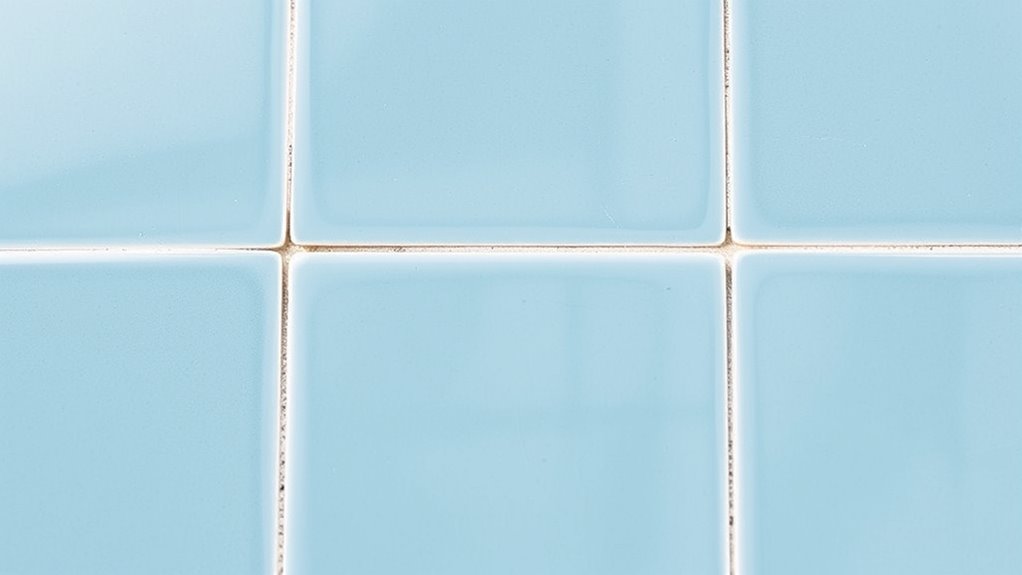
Waterline tiles offer a versatile opportunity to enhance your space with striking design elements. They serve as a focal point, adding color, texture, and personality to bathrooms or kitchens. To inspire your project, consider bold geometric patterns that create visual interest or classic subway tiles for a timeless look. You might opt for an accent strip with mosaic tiles to introduce a splash of color or texture variation that complements your overall style. Mixing different tile sizes and shapes can add depth and dimension, making your waterline stand out. Play with contrasting grout colors to emphasize patterns or keep it subtle for a seamless appearance. Incorporating expert appliance recommendations can also help ensure your waterline tile choices align with your overall design goals. These ideas help you craft a unique, personalized space that reflects your style and elevates your design.
Common Mistakes to Avoid With Waterline Tile Projects

One common mistake to avoid is neglecting proper surface preparation before installing waterline tiles, as this can lead to uneven adhesion and future cracking. Make certain the wall or surface is clean, dry, and free of debris or grease. Any uneven spots or bumps should be smoothed out or leveled to create a solid foundation. Skipping this step can cause tiles to loosen or crack over time, especially in high-moisture areas. Use a primer if needed, and check for moisture or mold before tiling. Incorrect surface prep also impacts grout adherence, increasing maintenance issues. Take your time to prepare thoroughly; it’s the best way to ensure your waterline tile project lasts and looks professional. Proper prep saves you time, money, and headaches down the line. Additionally, understanding the importance of surface compatibility can help you choose the right materials and ensure long-lasting results.
Frequently Asked Questions
How Do Waterline Tiles Affect Overall Bathroom Humidity Levels?
Waterline tiles can influence your bathroom’s humidity levels by reducing moisture absorption and preventing mold growth. If you choose high-quality, waterproof tiles, they’ll help keep the area dry and easier to ventilate. Proper grout sealing also minimizes water seepage behind the tiles, maintaining a balanced humidity. Regular cleaning and ventilation are essential to prevent humidity buildup, ensuring your bathroom stays comfortable and mold-free.
Are There Eco-Friendly Options for Waterline Tile Materials?
Did you know that choosing eco-friendly waterline tiles can reduce your bathroom’s environmental impact by up to 30%? You can opt for recycled glass tiles, which are made from post-consumer waste, or porcelain tiles, which are durable and require less energy to produce. These options not only help the planet but also add unique beauty to your bathroom, ensuring longevity and sustainability in your design choices.
Can Waterline Tiles Be Installed in Outdoor or Pool Areas?
Yes, you can install waterline tiles in outdoor or pool areas. Choose glazed ceramic or porcelain tiles, as they’re highly water-resistant and durable against weather conditions. guarantee proper installation with waterproof grout and sealants to prevent water penetration and damage. Opt for slip-resistant textures for safety, especially around pools. With the right materials and professional installation, your outdoor or pool waterline tiles will last and stay vibrant for years.
What Are the Best Practices for Repairing Damaged Waterline Tiles?
Think of damaged waterline tiles as cracks in a glass; you need to handle them carefully. First, remove broken tiles with a grout saw and chisel. Clean the area thoroughly. Apply new adhesive, set the replacement tiles, and let them cure. Finally, re-grout, smoothing the surface for a seamless look. Regular inspection and prompt repairs keep your waterline tile looking pristine and functioning perfectly.
How Do Waterline Tile Choices Impact Home Resale Value?
Your waterline tile choices can substantially boost your home’s resale value. Opt for classic, neutral colors and durable materials like ceramic or porcelain, which appeal to buyers and withstand moisture. Stylish patterns and high-quality grout also enhance visual appeal and longevity. When you select timeless designs and reliable materials, you create an attractive, low-maintenance feature that potential buyers appreciate, making your home more desirable and increasing its market value.
Conclusion
With the right materials, patterns, and grout choices, your waterline tile can stay beautiful for years. Don’t worry about maintenance—simple cleaning keeps it looking fresh, even if you’re busy. Remember, a little extra care now means fewer repairs later, saving you time and money. So go ahead, choose your favorite style and enjoy a stunning, durable waterline that adds lasting charm to your space. You’ve got this!
